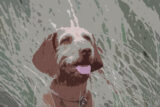Wirehaired Vizsla Breed Standard (UK)
(Revised Interim)
General Appearance: Medium sized, wire coated, distinguished appearance, with a more robust build and a stronger bone structure than the shorthaired vizsla.
Characteristics: Loyal, intelligent, obedient, sensitive, very affectionate and with patience easily trained. Bred for hunting fur and feather, pointing and retrieving from land and water.
Temperament: Lively, gentle mannered and demonstratively affectionate.
Head and Skull: Lively and intelligent expression. Skull moderately broad and slightly rounded, well proportioned and a little longer than muzzle, with moderate stop. Lips covering jaws completely and neither loose nor penulous. Bridge of nose is straight and ends in a broad nose. The colour of the nose is harmonious with the coat colour. Coat covering the head gives the head a somewhat square striking appearance.
Eyes: Neither deep nor prominent, of medium size and slightly oval in shape. Eyelids fitting tightly. Colour of eyes harmonises with coat colour, slightly darker shade desired. Yellow or black eye undesirable.
Ears: The ears are of medium set, proportionately long with a thin skin and hanging down close to cheeks. Rounded ‘V’ shape, not fleshy.
Mouth: Sound and strong white teeth. Jaws strong with perfect regular and complete scissor bite, i.e. upper teeth closely overlapping lower teeth and set square to the jaws. Full dentition desirable.
Neck: Well muscled and of moderate length, slightly arched and devoid of dew laps.
Forequarters: Shoulders well laid and muscular, elbows close to body and forelegs straight. Forearm long, pasterns straight.
Body: Strong and well proportioned, slightly longer in body measured from point of shoulder to point of buttock, than in height from withers to ground. Level back, slightly sloping croup rounded off towards tail set. Chest strongly developed, deep and reaching at least to the elbows. Ribs moderately well sprung and carried well back.
Hindquarters: Straight when viewed from rear, thighs well developed with moderate angulation, hocks well let down.
Feet: Slightly oval with toes short, arched and tight. Nails short, strong and a shade darker than coat.
Tail: Previously customarily docked.
Docked: Customarily docked by one third of length. Moderately thick and tapering towards the end, slightly low set. Carried horizontally when moving.
Undocked: Slightly low set. Moderately thick, slightly curved, tapering towards the end, reaching the hocks. Carried horizontally when moving.
Gait/Movement: Animated, flowing and ground covering, with a strong rear driving action.
Colour: Golden sand to russet. Small white marks on chest and feet should not be penalised.
Coat: The wire coat on the neck and body is harsh and close fitting, up to 4cms (1.5 ins) long, with an undercoat, which is normally heavier in winter. The hair on muzzle is short and course, the hair forming a small beard on the chin. The skull is covered by short, dry hair. Hair on the ears is short and fine. The eyebrows are dense. The coat is shorter on the lower part of the legs, chest and belly. Longer hair is permitted on the rear of the legs. On the feet and between the toes the hair is softer and shorter. Coat on the tail is dense and stronger.
Size: Height: Dogs 58-62 cms (23-24.5 ins) Bitches 54-58 cms (21.5-23insVarience of less than three centimetres is permitted as long as the dog remains in proportion.
Faults: Any departure from the foregoing points should be considered a fault and the seriousness with which the fault should be regarded should be in exact proportion to its degree.
Note: Male animals should have two apparently normal testicles fully descended into the scrotum.
